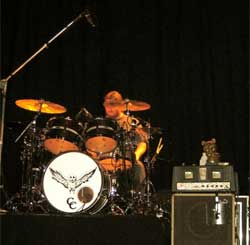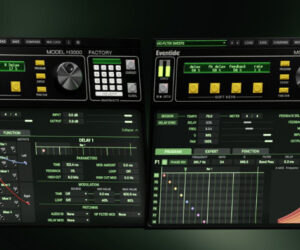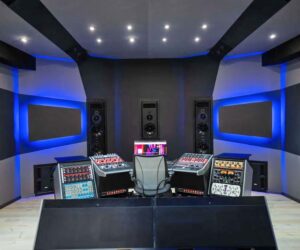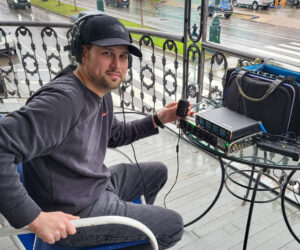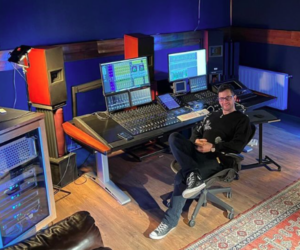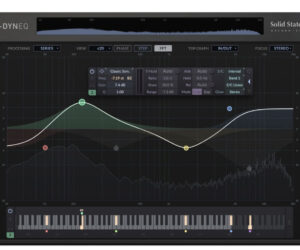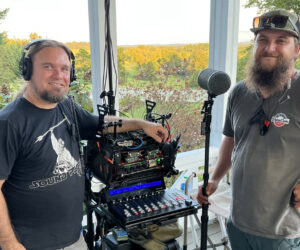Ryan Pickett, FOH and live performance archive recording engineer for the band My Morning Jacket, is currently using sE Electronics Voodoo VR1 passive ribbon microphones and patented sE Instrument Reflexion Filter 2’s (IRF2’s) on the band’s summer AmericanaramA Festival of Music tour with Bob Dylan and other guest artists.
Pickett, who has been working with the band for eleven years, has also been relying on sE Mics and Reflexion Filters, mixing and recording the band’s front man Jim James on his first solo project,
Pickett reports that when touring with My Morning Jacket he uses a pair of VR1 ribbon mics as a Blumlein pair—at a 90-degree angle with the capsules coincident—as drum overheads. He has also used VR1s on the guitar amps used by James and Carl Broemel.
The VR1 microphone, a passive version of sE’s VR2 active ribbon mic, achieves a 20 Hz—20 kHz frequency response through the use of a new patent pending mechanical device designed by Siwei Zou, sE Electronics’ founder.
“I chose the VR1 mic for its size and price point,” reports Pickett. “I love the added air at the top end of the VR1; it delivers more high-end than traditional ribbons. The drum sounds have become very open and natural, and cymbals no longer hurt. I also find myself using less EQ on the overhead channel strip,” he says. “And the VR1s are also low profile enough to allow me to get the right proximity without blocking the audience or drummer’s sight lines.”
Ryan continues, “The sE Microphones are very robust. That’s what really sets them apart from other ribbons. I’ve had other ribbon mics that were too delicate to take on the road, but I’ve had no problems with the VR1s. I really like the idea of being able to use studio mics in the live realm without having to worry about ribbon failure.”
Pickett is also using several sE IRF2 Instrument Reflexion Filters on tour in order to control bleed between instruments on-stage, customizing the hardware on the filter screens so that they can be used with z-bars on the backline cabinets.
“The IRF2s reduce spillover for the recording as well as for front of house and monitors,” he says. “I put them on the guitar amps. The keyboardist plays a lot of Fender Rhodes [piano] through a Fender Twin, so I put one on his amp, as there’s also a wedge blowing back into it. There’s another on the bass amp, because it’s usually pretty close to the drummer’s ride cymbal.”
My Morning Jacket first got the idea to use filters while performing a few dates with Tom Petty on which his FOH engineer, Robert Scovill, was using them. “The band took notice of this, and asked me, ‘Can we get those?” says Pickett. “ So we got in touch with Fingerprint Audio, the sE Electronics distributor for North America and we’ve been getting great support from them ever since.”
The value of the IFR2 was demonstrated on a show during one of James’ solo dates earlier this year, says Pickett.
“We got to the end of the tour and a z-bar had snapped. I didn’t have time to reassemble it for the show and basically put an M 88 mic on the cabinet. That’s when the monitor engineer and I both went, ‘Wow!’ The bass player is on ears, and her dynamics were completely different without that filter. Without the filter, her gain structure went way up, and didn’t sound as good. So that was a great testament to the filter.”
Pickett has also used the VR1s live for guitars on James and Broemel throughout the 2011 world tour, as well as on the band’s iTunes Session EP. “Recently I was rough-mixing a track by My Morning Jacket from the Paradiso in Amsterdam,” he says. “And I was blown away by the nuance and girth coming from the VR1s on the guitar amps!”
Pickett has also used sE Voodoo VR1 ribbons in the recording studio. On one recent project that he recorded at his studio, he used a pair of VR1s in a three-mic arrangement inspired by legendary engineer Glyn Johns.
“We used two VR1s placed equal distance from the snare, with one six inches from the floor tom and another overhead, 13 inches from the snare, with a Beyer M 88 on the beater side of the kick. The result sounded very round, warm and 3D. The size and sound were perfectly suited for that particular jazz application.”


